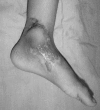Friction burns: epidemiology and prevention
- PMID: 21991101
- PMCID: PMC3188131
Friction burns: epidemiology and prevention
Abstract
This epidemiological study deals with 60 patients with friction burns between January 2004 and January 2006. The age group most affected was that between 21 and 30 years, with male predominance. Road traffic accidents were the commonest cause of friction burns (56 patients), and the lower limb was the most frequently affected part of the body. Patient management was performed according to the degree of the burn injury. It is suggested that most friction burn injuries are neglected on admission. They require proper care and can be prevented by the wearing of protective clothing, a helmet, and shoes while riding a motorcycle.
Les Auteurs de cette étude épidémiologique considèrent 60 patients atteints de brûlures causées par la friction entre janvier 2004 et janvier 2006. En ce qui concerne l'âge, les patients de 21 à 30 constituaient le groupe le plus nombreux, avec une prédominance du sexe mâle. Les accidents de la route étaient la cause la plus commune des brûlures par friction (56 patients), et le membre inférieur était la partie du corps la plus touchée. La gestion des patients dépendait du degré des brûlures. Selon les Auteurs, la plupart des lésions dues à la friction ne reçoivent pas toute l'attention nécessaire au moment de l'hospitalisation. Ces lésions nécessitent des soins appropriés et ils peuvent être prévenus en portant des vêtements de protection, un casque et des chaussures quand on conduit une motocycle.
Keywords: BURNS; EPIDEMIOLOGY; FRICTION; PREVENTION.
Figures












References
-
- Lanz U., Keller H.P. Abrasion injuries, combined burn injury of the hand. Hand Chir. Mikrochir. Plas. Chir. 1985;17:348–50. - PubMed
-
- Karoon Agrawal Friction burn. Indian J. Burns. 2003;11:28–9.
-
- Pegg S., Mayzee T.D. Burn injuries associated with motorcycles. Burns. 1982;9:288. - PubMed
-
- Borschel B.H., Wolter K.G., Cederna P.S., Franklin G. Acute management of exercise treadmill associated injuries in children. J. Trauma. 2003;55:130–4. - PubMed
-
- Tipler P. Physics for Scientists and Engineers (4th edition) 1998;1
LinkOut - more resources
Full Text Sources
